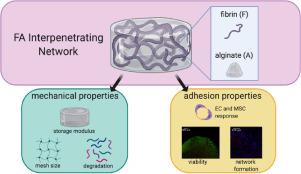当前位置:
X-MOL 学术
›
Acta Biomater.
›
论文详情
Our official English website, www.x-mol.net, welcomes your
feedback! (Note: you will need to create a separate account there.)
Tunable fibrin-alginate interpenetrating network hydrogels to support cell spreading and network formation.
Acta Biomaterialia ( IF 9.4 ) Pub Date : 2020-03-13 , DOI: 10.1016/j.actbio.2020.03.014 Charlotte E Vorwald 1 , Tomas Gonzalez-Fernandez 1 , Shreeya Joshee 1 , Pawel Sikorski 2 , J Kent Leach 3
Acta Biomaterialia ( IF 9.4 ) Pub Date : 2020-03-13 , DOI: 10.1016/j.actbio.2020.03.014 Charlotte E Vorwald 1 , Tomas Gonzalez-Fernandez 1 , Shreeya Joshee 1 , Pawel Sikorski 2 , J Kent Leach 3
Affiliation

|
Hydrogels are effective platforms for use as artificial extracellular matrices, cell carriers, and to present bioactive cues. Two common natural polymers, fibrin and alginate, are broadly used to form hydrogels and have numerous advantages over synthetic materials. Fibrin is a provisional matrix containing native adhesion motifs for cell engagement, yet the interplay between mechanical properties, degradation, and gelation rate is difficult to decouple. Conversely, alginate is highly tunable yet bioinert and requires modification to present necessary adhesion ligands. To address these challenges, we developed a fibrin-alginate interpenetrating network (IPN) hydrogel to combine the desirable adhesion and stimulatory characteristics of fibrin with the tunable mechanical properties of alginate. We tested its efficacy by examining capillary network formation with entrapped co-cultures of mesenchymal stromal cells (MSCs) and endothelial cells (ECs). We manipulated thrombin concentration and alginate crosslinking density independently to modulate the fibrin structure, mesh size, degradation, and biomechanical properties of these constructs. In IPNs of lower stiffness, we observed a significant increase in total cell area (1.7 × 105 ± 7.9 × 104 µm2) and decrease in circularity (0.56 ± 0.03) compared to cells encapsulated in stiffer IPNs (4.0 × 104 ± 1.5 × 104 µm2 and 0.77 ± 0.09, respectively). Fibrinogen content did not influence capillary network formation. However, higher fibrinogen content led to greater retention of these networks confirmed via increased spreading and presence of F-actin at 7 days. This is an elegant platform to decouple cell adhesion and hydrogel bulk stiffness that will be broadly useful for cell instruction and delivery. STATEMENT OF SIGNIFICANCE: Hydrogels are widely used as drug and cell delivery vehicles and as artificial extracellular matrices to study cellular responses. However, there are limited opportunities to simultaneously control mechanical properties and degradation while mimicking the complex native adhesion motifs and ligands known to encourage cell engagement with the hydrogel. In this study, we describe a fibrin-alginate interpenetrating network (IPN) hydrogel designed to balance the compliance and provisional qualities of fibrin with the mechanical stability and tunability of alginate to interrogate these contributions on cell response. We used clinically relevant cell sources, a co-culture of endothelial cells and mesenchymal stromal cells, to test its efficacy in supporting capillary formation in vitro. These data demonstrate the promise of this IPN for use in tissue engineering.
中文翻译:

可调节的纤维蛋白-藻酸盐互穿网络水凝胶支持细胞扩散和网络形成。
水凝胶是用作人工细胞外基质、细胞载体并呈现生物活性线索的有效平台。纤维蛋白和藻酸盐这两种常见的天然聚合物被广泛用于形成水凝胶,并且与合成材料相比具有许多优点。纤维蛋白是一种临时基质,含有用于细胞接合的天然粘附基序,但机械性能、降解和凝胶化速率之间的相互作用很难消除。相反,藻酸盐具有高度可调性但具有生物惰性,需要进行修饰以呈现必要的粘附配体。为了应对这些挑战,我们开发了一种纤维蛋白-海藻酸盐互穿网络(IPN)水凝胶,将纤维蛋白所需的粘附和刺激特性与海藻酸盐的可调机械性能结合起来。我们通过检查毛细血管网络的形成以及包埋的间充质基质细胞(MSC)和内皮细胞(EC)的共培养物来测试其功效。我们独立地操纵凝血酶浓度和藻酸盐交联密度来调节这些构建体的纤维蛋白结构、网格尺寸、降解和生物力学特性。在较低刚度的 IPN 中,与封装在较硬的 IPN 中的细胞 (4.0 × 104 ± 1.5 × 104 µm2) 相比,我们观察到总细胞面积显着增加 (1.7 × 105 ± 7.9 × 104 µm2),圆度降低 (0.56 ± 0.03)。和 0.77 ± 0.09,分别)。纤维蛋白原含量不影响毛细血管网络的形成。然而,更高的纤维蛋白原含量导致这些网络的保留更大,这通过 7 天时 F-肌动蛋白的扩散和存在的增加得到证实。这是一个优雅的平台,可以解耦细胞粘附和水凝胶体积硬度,将广泛用于细胞指令和传递。 意义声明:水凝胶广泛用作药物和细胞递送载体以及人工细胞外基质来研究细胞反应。然而,在模拟复杂的天然粘附基序和已知促进细胞与水凝胶结合的配体的同时,同时控制机械性能和降解的机会有限。在这项研究中,我们描述了一种纤维蛋白-藻酸盐互穿网络(IPN)水凝胶,旨在平衡纤维蛋白的顺应性和临时质量与藻酸盐的机械稳定性和可调性,以探究这些对细胞反应的贡献。我们使用临床相关的细胞来源,即内皮细胞和间充质基质细胞的共培养物,来测试其在体外支持毛细血管形成的功效。这些数据证明了该 IPN 在组织工程中的应用前景。
更新日期:2020-03-13
中文翻译:

可调节的纤维蛋白-藻酸盐互穿网络水凝胶支持细胞扩散和网络形成。
水凝胶是用作人工细胞外基质、细胞载体并呈现生物活性线索的有效平台。纤维蛋白和藻酸盐这两种常见的天然聚合物被广泛用于形成水凝胶,并且与合成材料相比具有许多优点。纤维蛋白是一种临时基质,含有用于细胞接合的天然粘附基序,但机械性能、降解和凝胶化速率之间的相互作用很难消除。相反,藻酸盐具有高度可调性但具有生物惰性,需要进行修饰以呈现必要的粘附配体。为了应对这些挑战,我们开发了一种纤维蛋白-海藻酸盐互穿网络(IPN)水凝胶,将纤维蛋白所需的粘附和刺激特性与海藻酸盐的可调机械性能结合起来。我们通过检查毛细血管网络的形成以及包埋的间充质基质细胞(MSC)和内皮细胞(EC)的共培养物来测试其功效。我们独立地操纵凝血酶浓度和藻酸盐交联密度来调节这些构建体的纤维蛋白结构、网格尺寸、降解和生物力学特性。在较低刚度的 IPN 中,与封装在较硬的 IPN 中的细胞 (4.0 × 104 ± 1.5 × 104 µm2) 相比,我们观察到总细胞面积显着增加 (1.7 × 105 ± 7.9 × 104 µm2),圆度降低 (0.56 ± 0.03)。和 0.77 ± 0.09,分别)。纤维蛋白原含量不影响毛细血管网络的形成。然而,更高的纤维蛋白原含量导致这些网络的保留更大,这通过 7 天时 F-肌动蛋白的扩散和存在的增加得到证实。这是一个优雅的平台,可以解耦细胞粘附和水凝胶体积硬度,将广泛用于细胞指令和传递。 意义声明:水凝胶广泛用作药物和细胞递送载体以及人工细胞外基质来研究细胞反应。然而,在模拟复杂的天然粘附基序和已知促进细胞与水凝胶结合的配体的同时,同时控制机械性能和降解的机会有限。在这项研究中,我们描述了一种纤维蛋白-藻酸盐互穿网络(IPN)水凝胶,旨在平衡纤维蛋白的顺应性和临时质量与藻酸盐的机械稳定性和可调性,以探究这些对细胞反应的贡献。我们使用临床相关的细胞来源,即内皮细胞和间充质基质细胞的共培养物,来测试其在体外支持毛细血管形成的功效。这些数据证明了该 IPN 在组织工程中的应用前景。











































 京公网安备 11010802027423号
京公网安备 11010802027423号